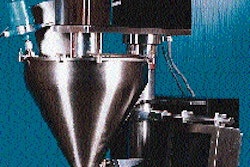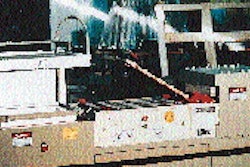
When color thermal-transfer printing debuted about a year and a half ago, it was a great idea whose time had come a bit too soon. Early printer models were said to be plagued with poor software, slow print times, registration problems and costly ribbons. Today a second generation of color thermal-transfer printers has made significant strides, causing a lot of packagers to take a second look.
One of the first companies to adopt this new version of color thermal-transfer printing technology was Maple Grove, MN-based Scimed Life Systems, a division of Boston Scientific Corp. A fast-growing manufacturer of medical devices, Scimed had been applying preprinted color labels-overprinted with variable data from a standard thermal-transfer printer-to preformed Tyvek pouches containing its guide wire products used in angioplasty surgery. The company had been stocking as many as 70 preprinted label formats, including labels for outer cartons.
While the preprinted labels looked great, it was becoming a burden to manage the label inventory due to the company's rapid growth and expanding product line. And since it packages products in small batches of 40 to 60, operators found themselves switching heavy preprinted rolls 15 to 20 times per shift. Another problem was that label design changes were making labels in inventory obsolete and took months to carry out.
Scimed knew it had to switch to on-demand printing, but it didn't want to be confined to black-only printing. Color labels quickly convey key aspects and features of the company's products. Solving both problems was a pair of Sundance 300-dpi four-color thermal-transfer printers from QuickLabel Systems (West Warwick, RI). They were installed in Scimed's Plymouth, MN, production facility in October '95. Computerized Machinery Systems, Inc., Labelmart Div. (Plymouth, MN), which actually sold and installed the printers, served as the distributor and ribbon advisor. Since then, Scimed has totally eliminated preprinted labels.
The benefits from this change are plenty. First, instead of tracking 70+ different preprinted labels, Scimed now uses two unprinted generic sizes. From a cost perspective, Scimed manufacturing engineer Bill Verkuilen estimates that Scimed eliminated a preprint inventory valued in excess of $250ꯠ. "That doesn't include warehouse space costs, purchasing costs, receiving inspection costs, transportation to the packaging area, and delays in production due to frequent changeover," Verkuilen adds.
This is perhaps the biggest benefit as the company's growth continues unabated. (Verkuilen recounts that upon joining the company three years ago, Scimed was producing about 200 wires per month; by the end of this year, Scimed forecasts closer to 50ꯠ/mo.)
Another benefit is speedy design changes. Before it could take up to three months to produce a new label design-including printer lead times, plate making times, and separate internal approvals for both the preprint and the variable print specs. Such changes can now can be done in a week or two, which consists mostly of waiting to obtain the necessary internal approvals; minor changes can be done in as little as a day.
Color craziness
In looking at a variety of color printing technologies-thermal-transfer, laser and ink-jet-Verkuilen had to sift through a variety of pluses and minuses. "Some printers were either significantly over our budget, and others took as long as 10 to 15 minutes to download the initial label format."
QuickLabel Systems Sundance printer seemed to overcome most of these problems gracefully enough. Initial label download takes about 45 seconds for the first label of the day. Once the graphics and foreign-language characters in Japanese (one of six languages on the label) are downloaded, the printer keeps that information in memory until it's turned off. Result: subsequent first-label-out times are almost instantaneous, especially if label content changes are minor from run to run.
The printer's four printheads each employ a different color ribbon (cyan, magenta, yellow and black). However, much like a traditional four-color press, each printhead can lay down a color either in full 100% coverage or in a percentage of coverage, e.g., 10%. By combining different colors at 100% coverage, up to seven solid colors can be produced by the printer. Unlike another color thermal-transfer printer that Verkuilen evaluated, the Sundance has the ability to simulate thousands of other colors by using true process printing, also known as "dithering." This technique involves mixing multiple colors in varying dot patterns or screen percentages, like a newspaper photograph.
For the moment, Scimed uses only solid process colors printed at 100%, usually four to five per label. The result is that the colors appear solid to the eye and are difficult to distinguish from preprint. There has been talk of incorporating dithered picture graphics on future labels.
Printing variable data in color was a feature beyond the capability of some printers, Verkuilen reports. According to Eric Sorensen of CMS Labelmart, other systems have both hardware and software limitations. This was a factor in Scimed's selection of the Sundance, even though most variable data-such as tip style, sterilization date, lot number, description and other information-is printed in black. Some variable items, like Scimed's Ice(TM) logo that signifies its Ice hydrophilic coating, is printed as a colored graphic element.
Other color printers would have required a separate overlabel for information as simple as a lot number, according to Verkuilen. That's not good enough, he says. "First, it ruins our just-in-time pursuit. Second, doing overlabeling brought up all kinds of issues about traceability and mixed up labels."
Software is a vital ingredient. Verkuilen experimented with another printer maker's software, but was unimpressed. Astromed's software seemed similar to Scimed's previous labeling software, resulting in minimal operator retraining.
Small-batch packaging
The packaging process starts out by calling up the appropriate label format from the computer connected to the label printer. Labels are printed in very small batches, usually 40 to 60, and are applied immediately after the batch is printed. Changeovers, which have already increased in frequency since the printers were installed, can number as many as 25 per shift. Yet they simply involve calling up different label information from the computer. "At times it's just a lot number change, but more often it's a model change, a tip style change, etcetera," says Verkuilen.
Labels, measuring 81/2" L x 5" W, are hand-applied to flat, empty premade pouches consisting of DuPont's (Wilmington, DE) Tyvek for the front, and clear medium-density polyethylene for the back. The guide wires are placed in 6' long protective flexible high-density PE tubes and are coiled to fit inside the pouches along with an instruction leaflet. Pouches are then heat-sealed shut. In another building, pouches undergo a 36-hour ethylene oxide sterilization process at 118°F, of which 12 hours is EtO exposure.
The printer hardware is the science part of color thermal-transfer printing, but the choice of appropriate color ribbon is still more art than science. Getting the right color ribbon with the right resin content that produces print that withstands the high temperatures of the EtO steriliztion process can be a challenge. Verkuilen credits CMS Labelmart with its ability to source the appropriate ribbon for Scimed's application. Though the current ribbons work well, experimentation with others is ongoing.
After sterilization, one or five pouches are placed in outer cartons. Another Sundance label printer produces a longer-length carton label measuring 93/8" L. That label is placed over the face of the carton, with the bottom 3/4" length folded over the edge of the tuck-fold carton. It serves as an end label that repeats much of the information from the face panel, and eliminates the need for a separate end label that Scimed had been using previously. Finished product is taken to warehouse storage to await distribution.
A few changes were necessary to adapt to the new labels. Since the preprinted labels were 7" W and the Sundance printers' maximum media width is 5", Scimed relocated some information from the label to the instruction leaflet. It's viewable through the clear side of the pouch. Other generic information, such as company address and warnings, are now preprinted on the folding cartons; formerly they were unprinted.
Uses standard stock
Supplied completely unprinted, Scimed's labelstock is the same as before, except for the difference in size. However, in marked contrast to before, the labelstock needs to be changed only 11/2 times per shift on average, or whenever a roll is depleted. Before Scimed converted to print-on-demand last October, it was experiencing 15 to 20 changeovers per shift. Each changeover required operators to unload and load heavy, 30-lb rolls of preprinted stock, sometimes resulting in back strain and elbow injuries.
However, the economics aren't all one-sided. With four label heads, four times as many ribbons are required, and the color ribbons carry an upcharge over standard black, says Verkuilen. Ribbons are 300 m long, and ribbons on each of the four heads are changed daily.
Even with increased ribbon costs, the conversion is worthwhile, maintains Verkuilen. He emphasizes that this project wasn't initiated to save costs; rather, it was to accommodate growth. "We felt that as long as we kept within a reasonable budget, startup costs weren't as important as the opportunity to automate in the future." As a result, specific costs on savings from preprint weren't available. Verkuilen does estimate that the printers have already paid for themselves, despite the higher costs of consumables.
With increasing production volumes, plans in the near term call for an automated form/fill/seal system to replace hand packing and preformed pouches. The thermal-transfer printer will be integrated with the f/f/s system to provide automatic labeling. The f/f/s approach would have made preprinted labels even more impractical. "That was another big reason why we went to this system," says Verkuilen. "Obviously we don't want to [shut down a f/f/s machine to] change labelstock every 40 or 50 labels. We wanted something that would permit a smooth, continuous-feed operation."





















